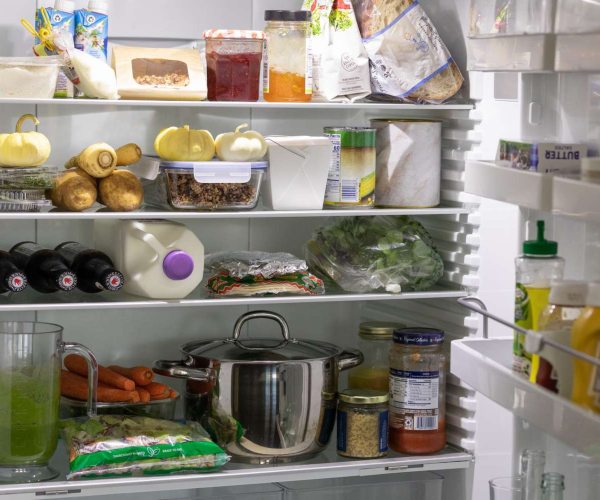The kitchen is undoubtedly the heart of a home therefore making it the dirtiest place in a home. The kitchen is a mess with lots of used dishes, a sticky floor, and a crusty oven. While you might think that your kitchen is neat and clean, there are often areas and objects that you seem to have overlooked. So, stop and ask yourself if there are places that you are forgetting to clean.
If you can’t think of any, just think about the areas or objects that you may be using while making food. These areas could be kitchen counters, handles, sinks, sponges, reusable water bottles, and many more. You often touch these items so it is necessary to disinfect them either every day or a few times a week so that they are free from built-up bacteria and cross-contamination.
-
Knobs, Handles, and Touch Pads
The dirtiest places in the kitchen are often overlooked. Every kitchen appliance in the kitchen has some type of control panel or handle that you touch each time when use it. Remember to clean all the knobs, buttons, or touchpads every week because we often tend to overlook them when giving our kitchens a deep clean. Mainly if you’re touching it with a when you’re cooking or handling raw food items. Make sure you also clean kitchen cabinet pulls, appliance handles and control panels using a disinfectant wipe or spray-on disinfectant cleaner and clean cloth or paper towel.

Also, Read Cheapest Kitchen Countertop Ideas for a Budget Makeover
2. Sink
One of the dirtiest places in the kitchen is the sink. There is plenty of water running through your sink and that might make you believe that your sink is clean. But there are likely microbes attached to the surface, especially in the crevices where the sink joins the counter, around the drain, and garbage disposal stoppers.
After every meal preparation and washing the dishes, disinfect the sink, and don’t forget the handles and faucet and the counter areas around the sink. Since they catch all the splatters when you wash off contaminated foods, it is essential to use a sink cleaner that has a disinfecting agent and a clean towel or disposable disinfectant wipes.
3. Sponges, Brushes, and Dishcloths
Many households have started using cellulose sponges, sink scrubbing brushes, and fabric dishtowels to reduce the use of paper towels. Sadly, kitchen sponges and cleaning brushes trap bacteria if not properly washed and disinfected.
If your kitchen has these items, wash them in hot water after each meal preparation or cleaning session. It is good to place sink and vegetable scrubbing brushes in the dishwasher for thorough cleaning after each use.
4. Refrigerator
We have previously discussed how dirty refrigerator handles and touchpads can be. Some harmful bacteria can grow and thrive inside your fridge even with cold temperatures.
If you do not wash most fruits and vegetables before storing them, chances are they will stay fresh longer. In that case, storing them unwashed to avoid spoilage is best. That being said, washing the drawers from time to time is necessary to avoid future contamination since food residues or bacteria can be left behind.

That’s the same case with raw meat that you store in the refrigerator. The meat’s packaging leaks and fluids get accumulated in the drawers and on the edges of the shelves. Do not forget that packaged products like milk or even butter tubs have been stored and handled many times before they get to your refrigerator.
To let any bacteria, yeast, and mold inside your fridge, remove drawers or shelves and if possible wash the surfaces with mild detergent and warm water. Dry the areas with a clean cloth or paper towel.
Between deep cleanings, you should wipe any spills and clean the interior surfaces with a disinfecting wipe.
Do not forget to dust off the appliance and vacuum behind and underneath as well. Remove the vent cover to vacuum the coils. Dust accumulated on coils makes the refrigerator less cool, using more energy, and food particles hiding underneath attract insects.
5. Cutting Boards
Cutting boards, mainly wooden boards can attract bacteria in the tiny nooks and crannies that happen after a single use. It is necessary to have at least two different cutting boards: one for meat and the other for fruits and veggies. By doing so, you are reducing cross-contamination during meal preparation.
After every use, wash the board with hot and soapy water and rinse well with hot water. Then, using a paper towel or clean dish towel, completely dry the board. Do not leave the board to dry on its own since bacteria prefer a warm and moist environment. Also, choosing a chopping board that can be placed in a dishwasher for proper cleaning is a good option.
6. Coffee Maker, Blender, & Small Appliances
It may surprise you to know that even clean water that is left over in a warm and moist environment such as a coffee maker can create a safe environment for bacteria, yeast, and mold to grow and live. Some small kitchen appliances need to be cleaned after a single use. Every week, disassemble and clean small appliances properly. Some items can be placed in the dishwasher and some need to be washed in hot and soap water and then rinsed deeply with hot water and dried.
The same goes for other utensils like openers, measuring spoons, and cups.
7. Reusable Lunch Boxes, Shopping Bags, & Water Bottles
Each time you use a reusable lunch box, shopping bag, or water bottle, there is a potential for cross-contamination from bacteria, unless you clean it thoroughly.

Completely disassemble the containers and keep them in the dishwasher or wash them in hot and soapy water rinse them thoroughly with hot water and dry completely. Most lunch boxes and reusable shopping bags can be washed in the clothes washer for proper cleaning.
Keep the shopping bags separated: one for cleaning supplies, one for raw fruits and veggies, one for raw meat, and one for packaged goods.
8. Countertops
You might think your kitchen counter is clean but they are often one of the dirtiest places in the kitchen where purses, shopping bags, and other necessary items are kept on top since it is a place to prepare food.
Take a disinfectant wipe or clean cloth and disinfectant spray and clean the countertop thoroughly before preparing food. Do not use the sponge or dishcloth because they may be hiding germs and bacteria. Once a week, take some time to get into corners, under small appliances, and along the edges between the stove or refrigerator and countertop. You never know what is hiding in those dark and moist spaces.
9. Salt and Pepper Shakers
One of the dirtiest places in the kitchen to think of is the kitchen salt and pepper shakers. Shakers are often used and touched frequently while preparing food. Give them a good wipe down with a disinfecting wipe after preparing every meal and clean them thoroughly every week.

FAQs
Q: What does a dirty kitchen contain?
A: Back kitchens or dirty kitchens are full kitchens with cleanup essentials like a deep sink and dishwasher along with a wall oven, freezer, wine refrigerator, and ample space for small appliances.
Q: What are the disadvantages of a dirty kitchen?
A: Having a messy kitchen means that there’s less counter space to use because more items and trash sit out and residents place them on the countertops. With less countertop space, you won’t have as much room to prepare meals, which can create a lack of functionality.
Q: What can you catch from a dirty kitchen?
A: “Common bacteria found in the kitchen include E. coli, salmonella, shigella, campylobacter, norovirus, and hepatitis A.” E. coli can survive for hours on a surface, salmonella can survive for about four hours and hepatitis A can survive for months.
Also, Read Decluttering Your Kitchen: Simple Steps for a Stress-Free Cooking Environment
